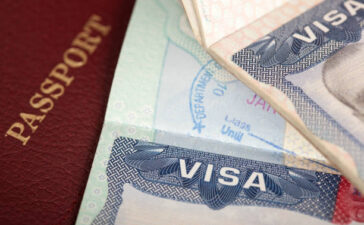Study in Canada – How International Students Can Transition to Permanent Resident Status
International students that study in Canada are a key source of talent for Canada. They are a young, skilled and diverse pool that has the potential to fill the country’s labour market needs.
Advertisement
However, the pathway to permanent residence is often multi-step and cumbersome, leaving them vulnerable to exploitation. This article examined cumulative rates of transition to permanent residency among international students.
1. Get a Job
One of the best ways to make friends in Canada and integrate with the community is to get a job. Getting your first job in Canada isn’t too hard with a little work and dedication. You’ll also find that if you get a job you can start to build a network and make connections with people that can help you in the future.
The first thing you need to do is ensure that you have a valid study permit to work in Canada. You can apply for a work permit on the same application form as your student visa. Once you have a work permit, you’ll need to find a job that suits your skills and interests.
There are a lot of different jobs available for students, from entry level positions such as retail or cafeteria staff to more senior roles such as finance or accounting. There are also a number of options for students who want to take on an internship or co-op position.
Working while you are studying will give you a chance to meet people from all walks of life, making friends that can help you in your future career. It will also be a good way to support yourself throughout your studies and help you to cover living costs.
Advertisement
Once you graduate, you may be able to apply for the Post Graduation Work Permit Program (PGWPP) which allows you to continue working in Canada for up to three years after graduation. This can provide a pathway to permanent residence through the Express Entry immigration system.
2. Get a Study Permit to Study in Canada
Canada is a world-class study destination, home to top-tier universities and colleges, and vibrant multi-national student communities. International students want to take advantage of that, but first they need a study permit.
It is possible to get a permit at the Port of Entry (POE) in Canada after receiving conditional acceptance for an academic program and completing a English for Academic Purposes (EAP) course. However, it’s generally easier to apply from home before you arrive in the country.
The key to getting a study permit is demonstrating to an officer that you will leave at the end of your permitted stay in Canada. And that you have financial resources to cover tuition fees and living expenses while you’re studying. This means that you must have personal savings or a letter from a sponsor showing that they are able to pay your expenses.
This money must be allocated specifically for your education and not used for any other purposes. Be easily accessible (not locked up in long term investments), and come from a source that is known to you. The sponsor must identify themselves and provide full contact details. State their relationship to you (if applicable), and attest that they will continue to pay your expenses after you’ve graduated.
Having a good record of school attendance and maintaining good grades are also important for getting a study permit. Moreover, a good relationship with your school and a strong plan for graduation are additional positive factors.
If your application is rejected, you will be told why and given a chance to reapply. If your application is approved, you’ll be given a document number called a Unique Client Identifier (UCI) and the process will begin.
3. Apply for Permanent Residency
A growing number of international students see their Canadian education as a gateway to permanent residency. They’re young, proficient in both of Canada’s official languages, and have an educational qualification that will make them valuable additions to the country’s labour force. According to the Government of Canada, this makes them “an excellent pool to consider for immigration”.
As a result, they’re often seen as an ideal candidate for the Federal Skilled Worker (FSW) program, a points-based Comprehensive Ranking System (CRS) assessment that invites the highest-scoring candidates to apply for Canadian citizenship. Currently, the FSW program accepts applicants with CRS scores of less than 400, and is one of the most popular routes to permanent residence for international students.
A recent study titled ‘From Student to Immigrant: Multi-Step Pathways to Canadian Citizenship’ found that most international students experience multiple hurdles on their road to citizenship. The study also noted that the process of becoming a permanent resident is complicated for international students because they typically hold multiple temporary visas, leaving them vulnerable to exploitation by employers or losing their immigration status.
The study looked at the cumulative transition rates of international students to Canadian citizenship over a 10-year period. And analyzed these by a variety of sociodemographic characteristics at the time of arrival and the intended level of study. It found that those who gained employment in Canada before or after their studies were more likely to become landed immigrants. And that a higher level of earnings was associated with greater likelihood of transition to permanent residency.
4. Apply for Citizenship to Study in Canada
Many international students see their studies as a way to obtain a Canadian citizenship. And Canada’s welcoming immigration policies allow them to move toward this goal at a rapid pace. If you’re thinking about applying for Canadian citizenship. Be sure to meet the minimum residency requirements and make a strong case that you belong in Canada.
The standard route for moving to permanent residence is to graduate with a degree from a qualifying academic program, obtain a post-graduation work permit (if eligible), then knuckle down and do a year of skilled work under this work permit. This will add to your CRS score and improve the likelihood that you’ll receive an invitation to apply for PR sooner than you would have otherwise.
If you’re a former international student, you can also consider applying for Canadian citizenship through the Canadian Experience Class (CEC). This immigration category allows individuals who have worked in Canada for at least one year to immigrate permanently. You’ll need to submit an Express Entry profile and meet the criteria for this stream. You’ll also need to demonstrate that you know enough about Canada. Also the English or French language to be a good fit for this country.
In order to qualify for the CEC, you’ll need to be a permanent resident in good standing, have submitted Income Tax returns for three of the past five years, and possess adequate knowledge about Canada and the English or French language. You’ll also need to pass the Citizenship Test, which consists of 20 questions that you need to answer correctly. You can prepare for the test by using a study guide, attending an information session, or consulting with an authorized immigration consultant. You can find more information about the Citizenship Test on IRCC’s website.




